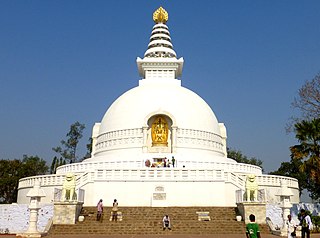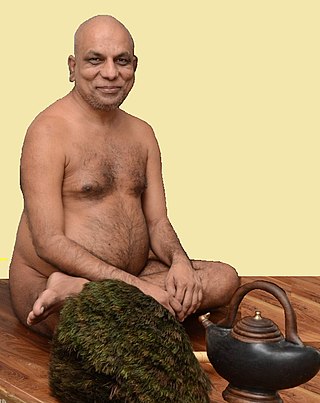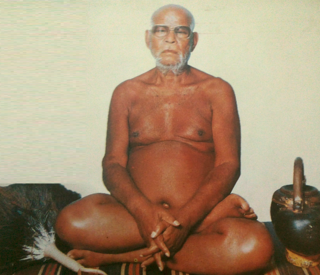
Mahavir Janma Kalyanak is one of the most important religious festivals in Jainism. It celebrates the birth of Mahavira, the twenty-fourth and last Tirthankara of present Avasarpiṇī. On the Gregorian calendar, the holiday occurs either in March or April.

Rajgir, old name Rajagriha, meaning "The City of Kings," is an ancient city and university town in the district of Nalanda in Bihar, India. It was the capital of the Haryanka dynasty, the Pradyota dynasty, the Brihadratha dynasty and the Mauryan Empire, as well as the dwelling ground of historical figures such as Buddha, Mahavira and Bimbisara. Due to its religious significance, the city holds a place of prominence in Hindu, Buddhist and Jain scriptures. As of 2011, the population of the town was reported to be 41,000 while the population in the community development block was about 88,500.
Paryushana is an annual holy event for Jains and is usually celebrated in August, September or October in Hindi calendar Bhadrapad Month's Shukla Paksha. Jains increase their level of spiritual intensity often using fasting and prayer/meditation to help. The five main vows are emphasized during this time. There are no set rules, and followers are encouraged to practice according to their ability and desires. The event lasts for 8 or 10 days, and ends with the celebration of Samvatsari.

Adherents of Jainism first arrived in the United States in the 20th century. Jain immigration began in earnest in the late 1960s and continues to the present day.

Acharya Vidyasagar was an influential Indian Digambara Jain acharya (monk), credited with having brought about a revival in educational and religious activities in Digambara Jainism. He wrote the epic Hindi poem Mukamati.
Avadhānaṃ is a genre of performance in India, where a performer answers challenging questions from several questioners in parallel. The most popular variety, called sāhitya (literary) avadhānam involves the performer composing poetry, thereby entertaining the audience and demonstrating the poetic skills of the performer. The art form was developed particularly by Telugu poets in medieval times. It involves the partial improvisation of poems using specific themes, metres, forms, or words. There is a tradition of mentoring in Avadhanam. The best avadhanis have contributed to the oeuvres of Telugu and Kannada poetry.

Acharya Shri Shantisagar Ji (1872–1955) was an Indian Acharya of the Digambara monk faith. He was the first Acharya (preceptor) and a leader of his digamber sect in the 20th century. Shanti Sagar ji revived the teaching and practice of traditional Digambara practices in North India. He was lustrated as a kshullaka into the Sangha by Devappa (Devakirti) Swami Ji. He took his ailaka deeksha before an image of the Tirthankara Neminatha. In about 1920, Shantisagar Ji became a full muni (sadhu) of the Digambara. In 1922, at Yarnal village, Belgaum district, Karnataka, he was given the name "Shanti Sagar Ji".

Jain meditation has been the central practice of spirituality in Jainism along with the Three Jewels. Jainism holds that emancipation can only be achieved through meditation or shukla dhyana. According to Sagarmal Jain, it aims to reach and remain in a state of "pure-self awareness or knowership." Meditation is also seen as realizing the self, taking the soul to complete freedom, beyond any craving, aversion and/or attachment. The 20th century saw the development and spread of new modernist forms of Jain Dhyana, mainly by monks and laypersons of Śvētāmbara Jainism.
Jainism is an ancient Indian religion belonging to the śramaṇa tradition. It prescribes ahimsa (non-violence) towards all living beings to the greatest possible extent. The three main teachings of Jainism are ahimsa, anekantavada (non-absolutism), aparigraha (non-possessiveness). Followers of Jainism take five main vows: ahimsa, satya, asteya, brahmacharya (chastity), and aparigraha. Monks follow them completely whereas śrāvakas (householders) observe them partially. Self-discipline and asceticism are thus major focuses of Jainism.
Hindu terrorism, sometimes called Hindutva terror or, metonymically, saffron terror, refer to terrorist acts carried out on the basis of motivations in broad association with Hindu nationalism or Hindutva.

Acharya Vijay Vallabhsuri was a Jain monk. He was a disciple of Vijayanandsuri. He worked in Punjab so he was given honorific Punjab Kesari.

Sushil Kumar was a Jain teacher and monk. He was a self-realized master who devoted more than 50 years to promoting non-violence, peace and knowledge of the self.
Panch Kalyanaka are the five chief auspicious events that occur in the life of tirthankara in Jainism. They are commemorated as part of many Jain rituals and festivals.

Sahityacharya Dr. Pandit Pannalal Jain was a distinguished Jain scholar. Dr. Kasturchand Kasliwal has regarded him as among the 20 most distinguished of the Jain scholars of 20th century His teaching career spanned 70 years, from 1931 to 2001.

Muni Tarun Sagar was an Indian Digambara monk. His lectures are termed Kadve Pravachan because they can be candidly critical of common practices and views. His lectures have been compiled and published in book series also titled Kadve Pravachan. Excerpts from his discourses are often published by newspapers. Unlike most other Digambar Jain monks, his audience often included a majority of non-Jains. His discourses often addressed family or society issues.

Munishri Pramansagarji Maharaj is a Digambar monk of Terapanth sub-sect. He is an able disciple of Acharya Shri Vidyasagar Ji Maharaj. He has set free the religion from traditional abstruseness and made it practicable in life. Through his sermons and initiatives, the process of a qualitative change in society has begun. He led a campaign to save the Jain tradition of Santhara also known as Sallekhana in the year 2015, in which millions of Jain community members took out massive silent rallies in several cities and towns all over the world against the Rajasthan High Court decision. Gunayatan is one of his important religious initiatives which is going to become a centre for self-development in the true sense. His pravachans and Shanka Samadhan programme are aired on Jinvani Channel and Paras TV Channel.

Acharya Deshbhushan was a Digambara Jain Acharya of 20th century who composed and translated many Kannada scriptures to Hindi and Sanskrit. He initiated and elevated several Jain monks and nuns like Shwetpichhi Acharya Vidyananda ji and Gyanmati Mataji. He is renowned for his remarkable translations of Kannada scriptures to Sanskrit and Hindi. He is the first Digambara Acharya to visit and address the Indian Parliament in the year 1974 along with the Prime Minister Indira Gandhi.

Muni Shri 108 Kshamasagar ji Maharaj was a Digambara monk initiated by Shri 108 Acharya Vidyasagar ji Maharaj. He is also known for his poetry and writings which are widely quoted.

Thirupanamoor and Karanthai are twin villages about 19 km from Kanchipuram. They host historically important Jain temples containing historical inscriptions. There is a population of local Jains in these and nearby villages.

Siddhantacharya Pandit Phoolchandra Shastri was a Jain scholar, writer, editor, freedom fighter, social reformer and an intellectual giant in the field of Jainism. He is best known for dedicating a major part of his life in translating to Hindi the foremost and the oldest Digambara Jain Canon Shatkhandāgama and Kasayapahuda and its commentaries Dhavala, Maha-Dhavala and Jai-Dhavala. He was also an active member of Indian National Congress during the Indian freedom struggle. He was also a strong advocate and proponent of abolishing many evils within the Jain community. Panditji was also the founding member of many institutes of learning and scholarship. As a recognition of his contribution to Jain philosophy, he was conferred a title of "Siddhantacharya" at Jain Siddhant Bhavan, Ara (Bihar) in 1962 by the Governor of Bihar Ananthasayanam Ayyangar.















